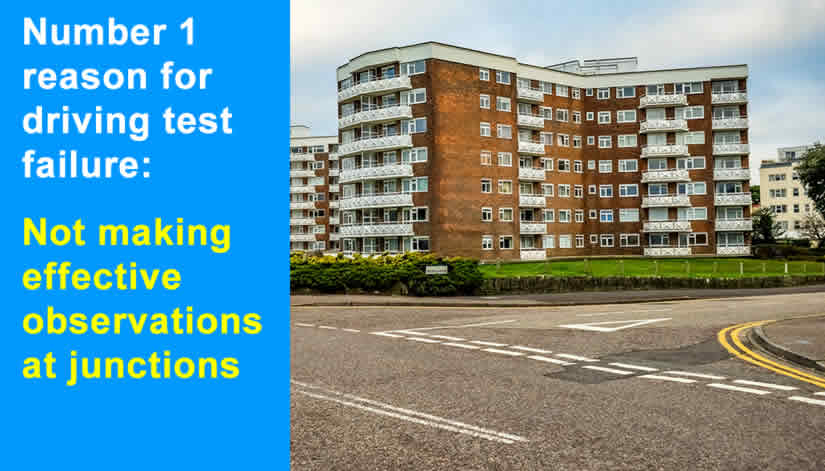Failure to make effective observations at junctions is the number 1 reason for failing a driving test. In fact, it’s the top reason for test fails each and every year. A junction is defined by a location where two or more roads meet and include:
- T-junctions
- Left or right turns from a major road to a minor road
- Crossroads
- Roundabouts
- Joining a dual carriageway
Reasons Why Tests are Failed at Junctions
The examiner will mark the ‘junctions – observations’ fault box on the driving test report when the test candidate fails to:
- Take effective observations before moving into a new road
- Ensure that it’s safe before proceeding into the new road
These are the main reasons why examiners fail driving test candidates for a lack of effective observations at junctions.
Failing to Properly Judge the Speed of an Approaching Vehicle
A common mistake that test candidates make is when exiting a T-junction from a minor road, they fail to correctly judge the speed of an approaching vehicle. In this instance, they move out into the new road, forcing the approaching vehicle to slow down.
Learning to judge the speed of other vehicles take practice and an understanding that the road in which they intend on entering may have a different speed limit to the road that they’re exiting. Additionally, test candidates often feel that if they wait too long, they will get marked down for being too hesitant. It’s better to be a little too cautious than too hasty.
Failing to Make Any Observations
An instant test failure involves candidates emerging from a junction and failing to carry out any effective observations at all. In this instance, it may result in approaching traffic from either the left or right having to do an emergency stop to avoid a collision, or if the vehicle has dual controls, the examiner having to use the brake, to prevent the vehicle from entering the new road.
Late Observations
Making effective observations is one thing, but timing them right is equally important. This fault involves the test candidate emerging from a junction and making observations, either to the left or right too late. The observations are no longer effective due to the candidate already partly into the next road.
This can often be the result of the test candidate approaching the junction too fast. The result of the is that there’s too much to do when they get there and not enough time to do it.
Not Looking Left when Turning Left
This situation involves the test candidate turning left from a minor road onto a main road and repeatedly failing to make effective observations to the left. This is due to the test candidate’s priority with giving way to traffic on the right. It is however equally important to observe to the left as there could be parked cars or other hazards that could be in your path.
Entering a Roundabout with an Approaching Vehicle
Roundabouts are a common form of junction throughout our towns and cities and examiners will test candidates on the most challenging roundabouts in the area.
Many learner drivers and test candidates fear roundabouts due the difficulty in trying to anticipate where traffic already on the roundabout is heading. A common test failure here, is where the test candidate enters the roundabout with a vehicle approaching from the right, causing the vehicle to slow down.
This usually occurs as the test candidate is approaching the roundabout and rather than taking the decision to stop, they continue onto the roundabout. Always approach junctions at an appropriate speed that allows you sufficient time to think and safety stop if required.
Lack of Observations or Failing to Give Way when Entering a Dual Carriageway
Joining dual carriageways is another procedure that many learner drivers and test candidates fear. If you have a dual carriageway in the area of your test centre, it’ll almost certainly be a part of the test routes.
Common test failures involve the test candidate joining the dual carriageway via a slip road and failing to make any effective observations and as a result, failing to give way to traffic on the main carriageway. If it involved a lack of effective observation only, it will be marked as a serious fault and if the test candidate’s actions would have impacted another vehicle without the examiner’s intervention, it will be marked as a dangerous fault.
Entering a dual carriageway via a slip road requires matching the speed of your vehicle, to the speed of the vehicles on the dual carriageway and this is often high speed. It’s important to continuously and quickly alter your observations from where you are traveling and to what’s happening on the carriageway. Don’t forget to check over your right shoulder in the blind spot just prior to entering the main carriageway.
Going Straight Ahead at Crossroads
This fault involves the test candidate approaching a crossroads and failing to observe and recognise that it’s a junction. The candidate emerges into the junction and crosses without making any observations. Again, this will result in a serious or dangerous fault.
It’s important to always look out for signs or road markings that warn of a junction. Some crossroads are unmarked, so pay attention to any gaps to the left and right up ahead that may indicate a junction is ahead.
